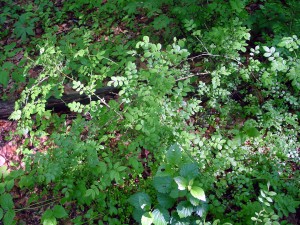A writer from the News Journal heard about invasive microscopic rose bud mites in Delaware that are killing plants. She became concerned and wanted to learn more about this situation. These are very small eriophyid mites that spread rose rosette disease, also known as witches’-broom of rose, which is caused by a virus (Emaravirus sp.). The disease is limited to plants in the genus Rosa but some roses are believed to be resistant. Its main host is the multiflora rose, which is considered an invasive plant in Delaware. Multiflora rose has a small white flower in early spring and has taken over many natural areas in Delaware. It can grow as a shrub or a vine and become intertwined with other shrubs and trees in the woods. Interest in rose rosette has been generated by the threat to garden roses and also its possible use as a biocontrol for multiflora rose.
Rose rosette disease starts as a red color on the underside of leaf veins and quickly progresses to sharply increased growth at branch tips. The growth is more succulent than normal and colored in various shades of red. Leaves often become deformed, crinkled, and brittle with yellow mosaics and red pigmentation. As the disease progresses, leaves become very small, petioles are shortened, and most lateral buds grow, producing short, intensely red shoots (witch’s broom). The disease causes the plant to be exceptionally susceptible to freeze damage. Symptoms on cultivated roses are typically less severe than on multiflora rose. Symptoms can be confused with some forms of herbicide damage.
The disease is transmitted by an eriophyid mite, a wingless mite that can travel passively in the wind as well as on contaminated clothing and equipment. The mites feed and reproduce in the tips of rose shoots. Females overwinter under bark or on bud scales of living roses. The females move to newly developing shoots where they lay one egg a day for about 30 days. The young hatch in 3-4 days. They can reach adulthood in about a week depending upon temperatures. Multiple generations occur each year until fall when females seek overwintering sites. The mites are hampered by low humidity and can only survive about 8 hours without being on a host plant.
The virus is transmitted most readily between May and mid-July when plants are actively growing. Symptoms from new infections usually start appearing in mid-July. In general, smaller plants go through the disease stages more quickly than larger plants. Small plants are usually killed in about 2 years, while a large plant may survive for five years in a deteriorated condition.
To control this disease, you can:
- Remove ornamental roses with symptoms. Remove and destroy the entire plant including the roots by burning or placing in a plastic bag. Take care when working with diseased plants as you can spread the mites that spread the disease. Bag the plant before removal, cut it at ground level and then dig out the plant’s roots. Soil need not be removed. Clean tools and put on fresh clothing before moving to a disease-free plant or area.
- Plant ornamental roses as far away as possible from known stands of multiflora rose. Maintain at least 300 feet between your roses and any stands of multiflora rose. Even greater distance is preferred especially if they are upwind of your desirable rose plants.
- Control the disease by controlling the mite. Start mite control early by pruning your roses hard in late winter (back by 2/3) to remove as many overwintering mites as possible and then spray with horticultural oil to kill any remaining mites. Use horticultural oil or soap, which are less harmful to natural predators that feed on the problem mites. Apply weekly during the months of June and July paying particular attention to the new growing tips where the mites will congregate. Refrain from using leaf blowers around roses as they can spread mites.
- Help to isolate your roses. Do not plant roses too close together. With extra space between the plants mite movement can be reduced. Also, consider interplanting roses with other ornamental plants.
- Using rose rosette disease as an IPM strategy. The multiflora rose is an exotic invasive species that is responsible for the degradation of millions of acres of farmland and recreational areas. Using the disease to control this invasive weed can cut costs and be considered environmentally friendly for reducing the amount of synthetic chemicals used. However, the disease also affects cultivated roses. One should be extremely cautious and good neighbor-minded when it comes to rose rosette disease.



Great info. Thanks for the article. As a florist and gardener I greatly appreciate it.